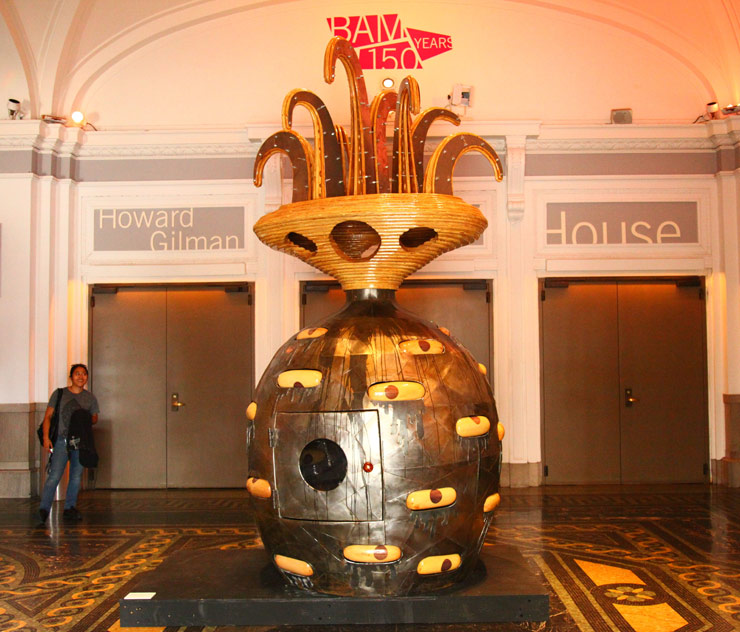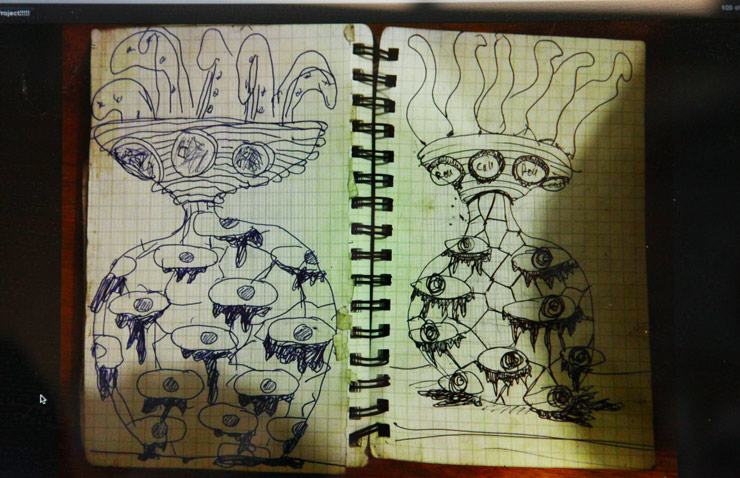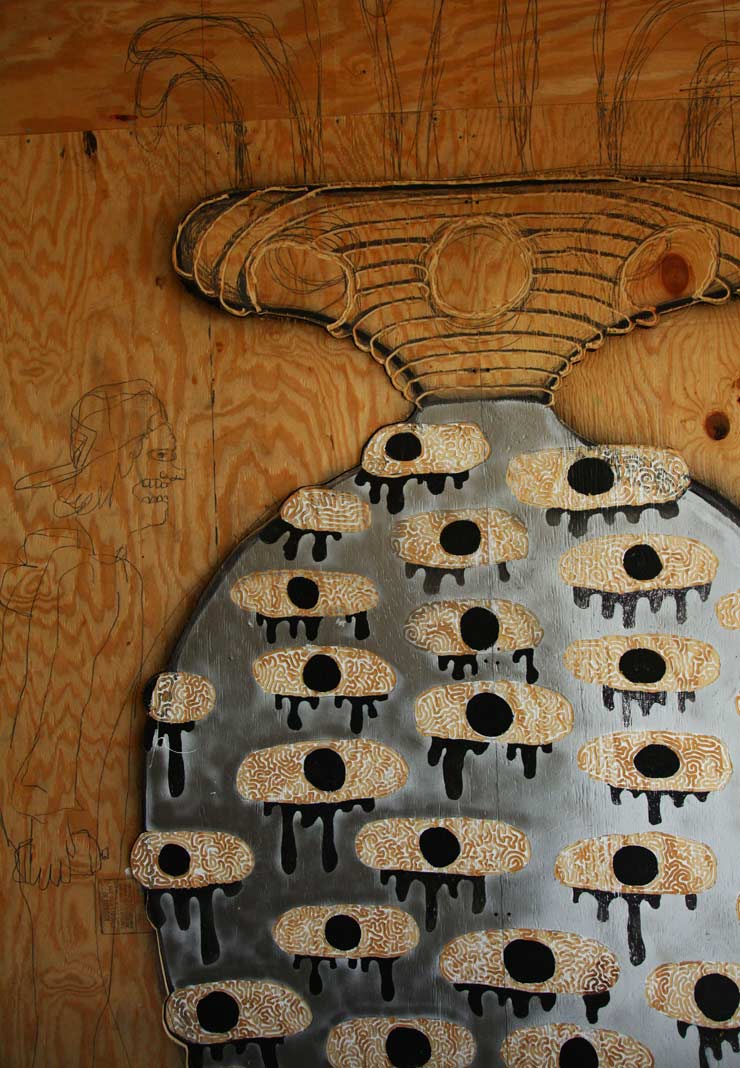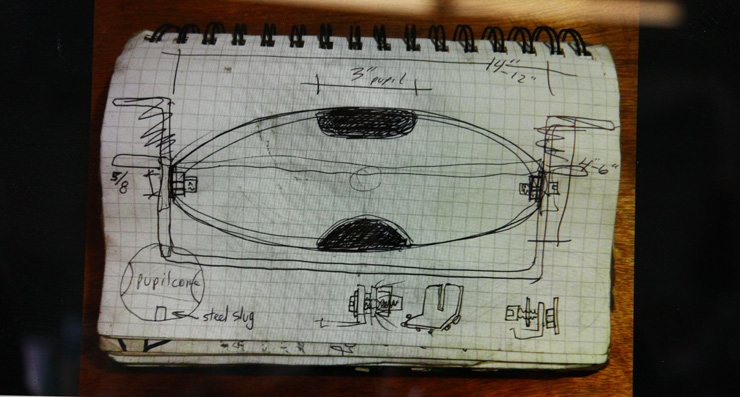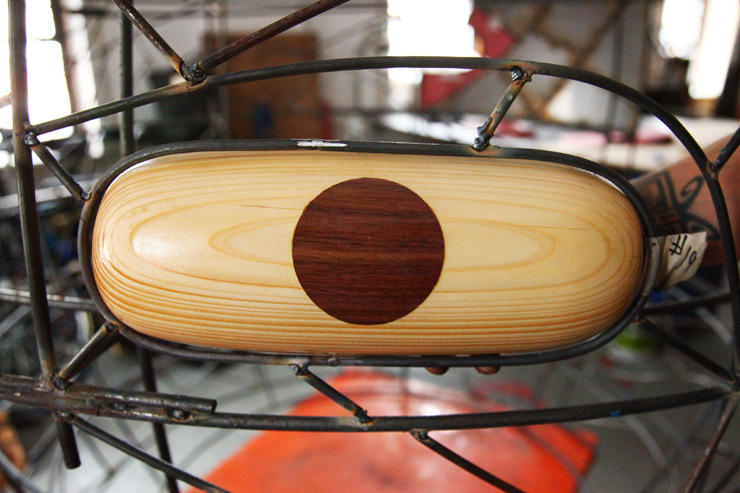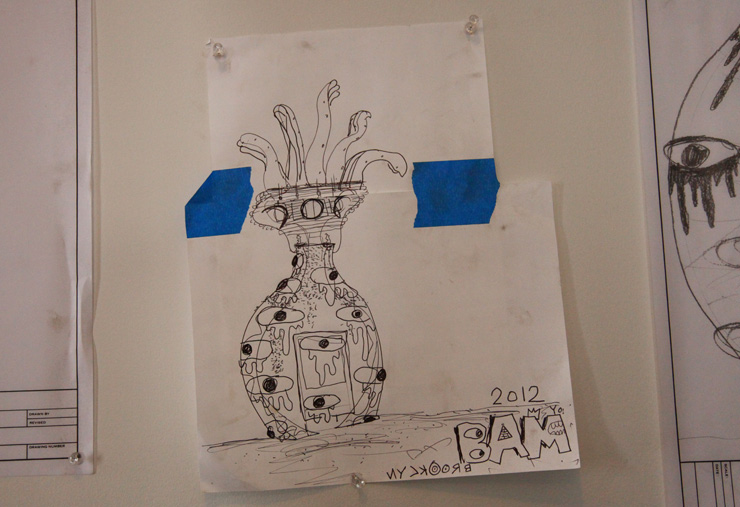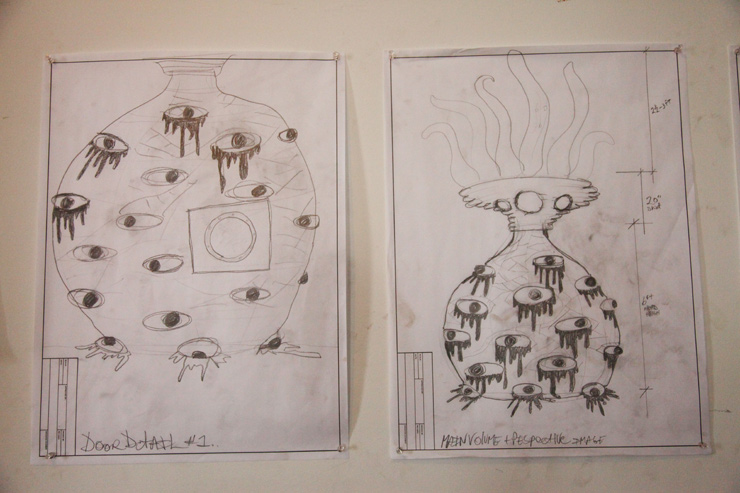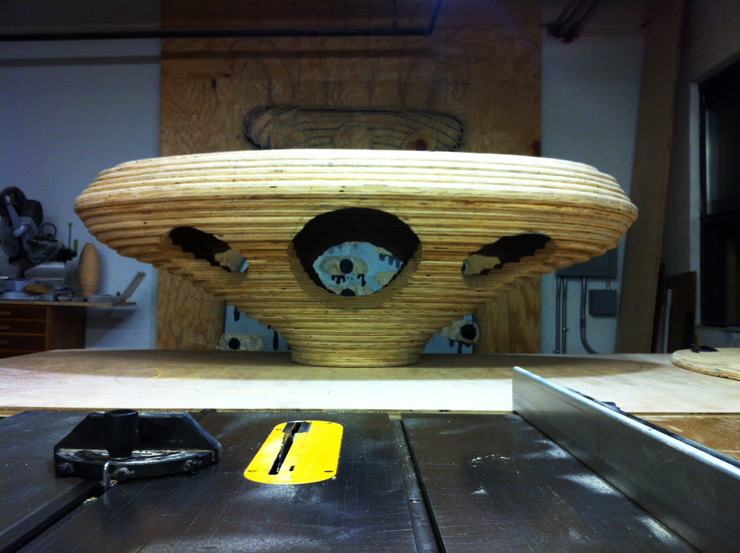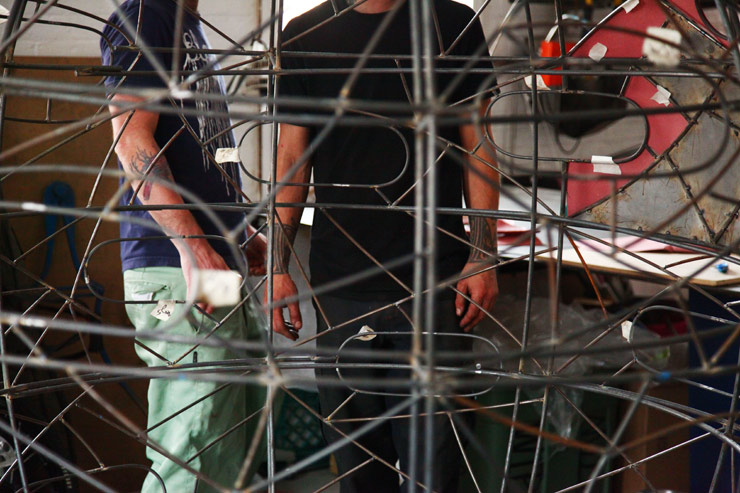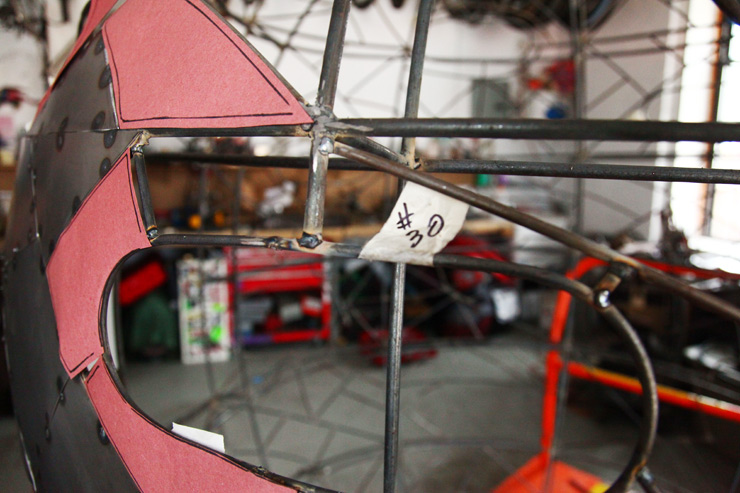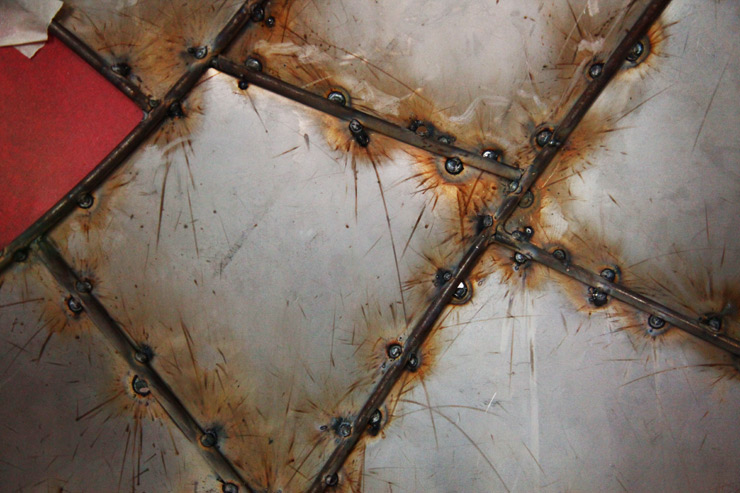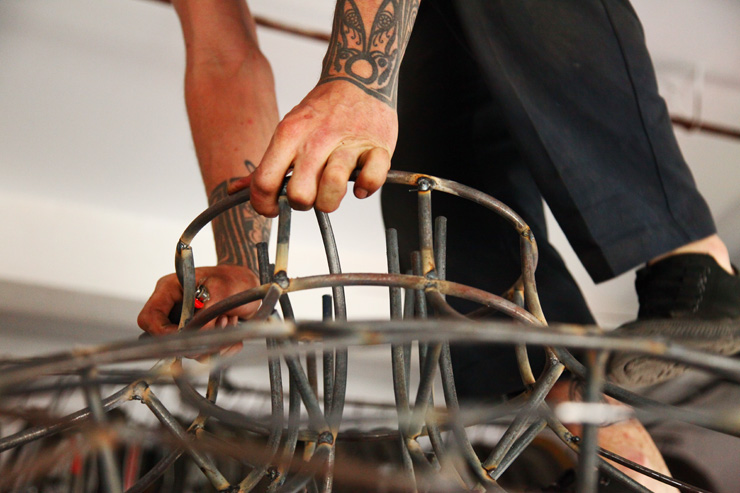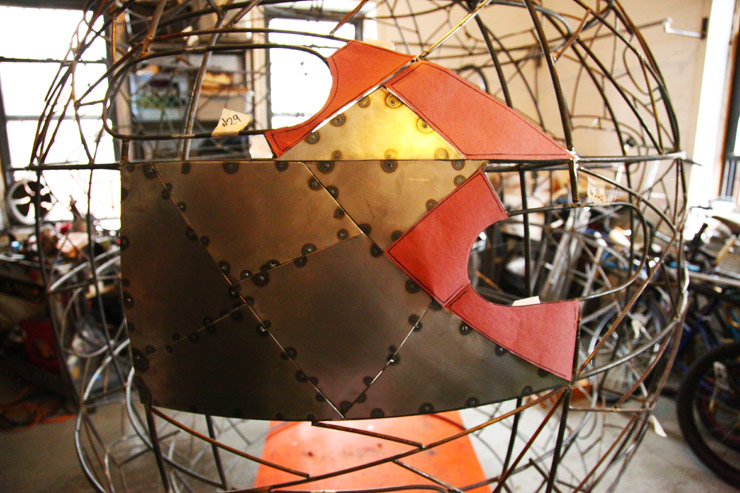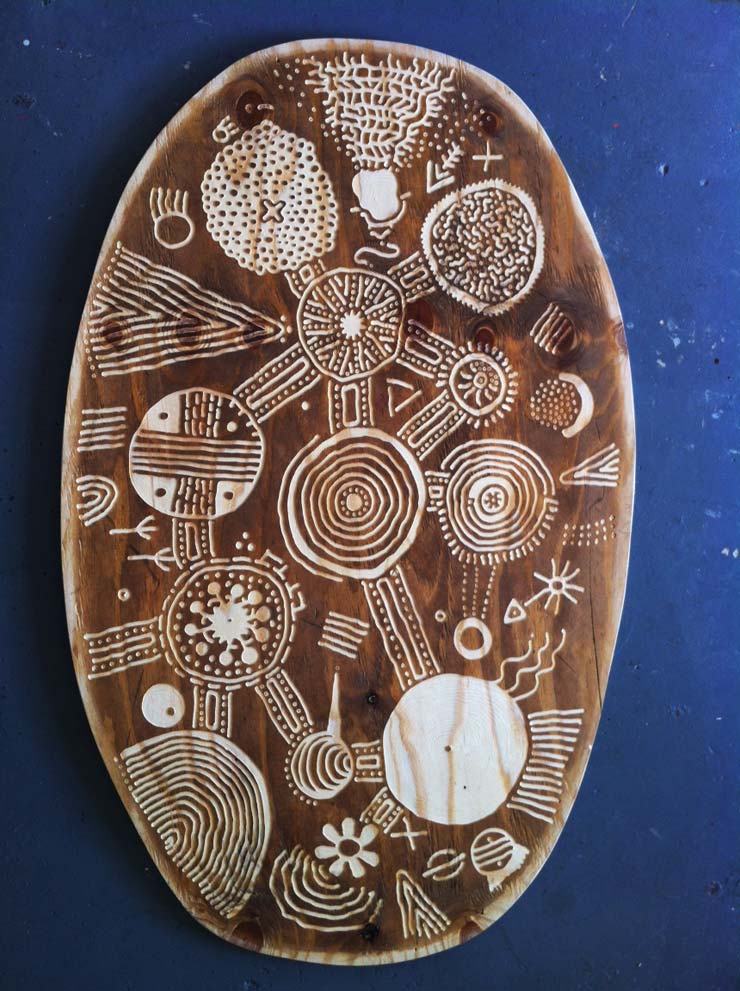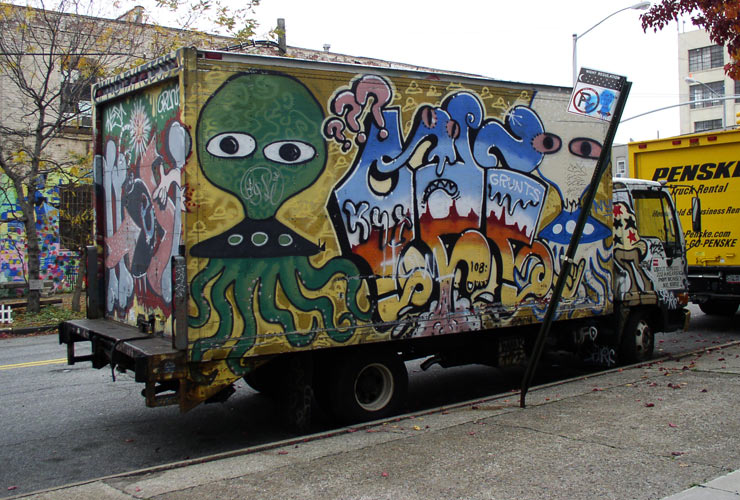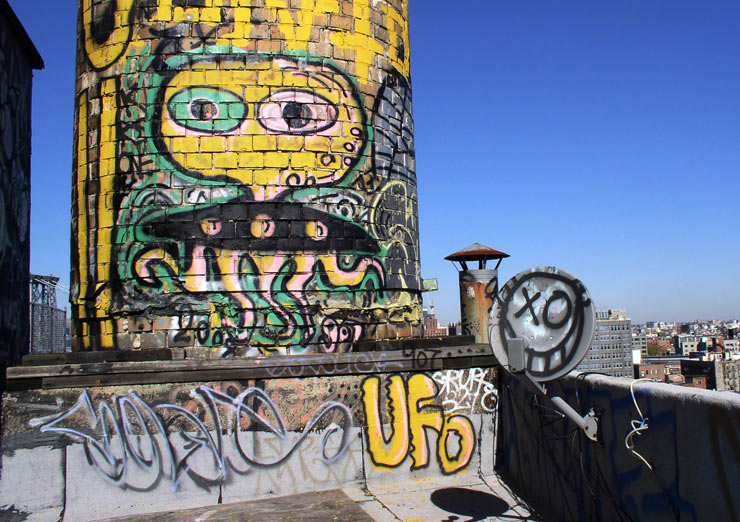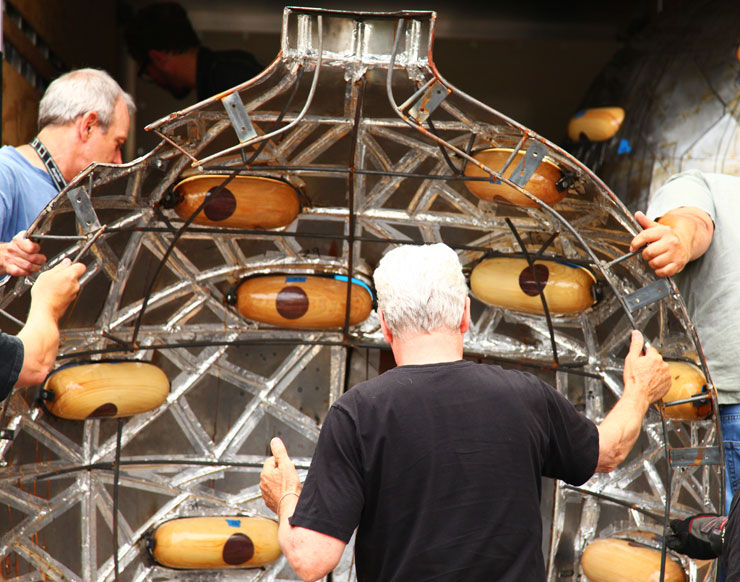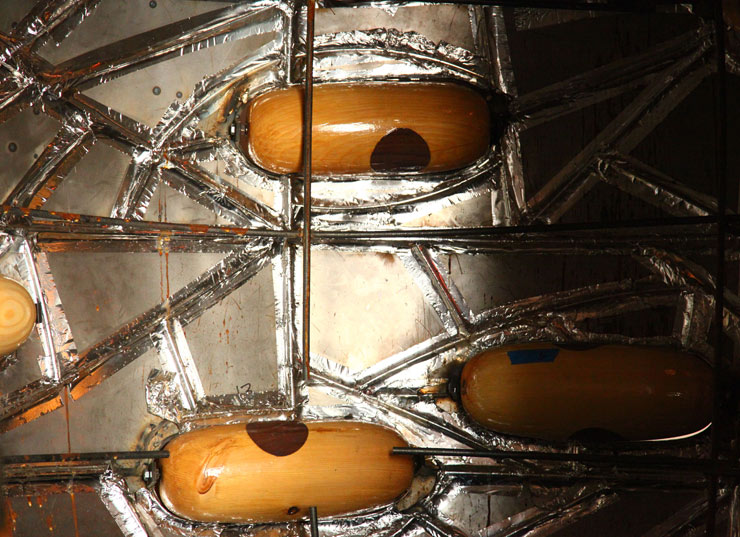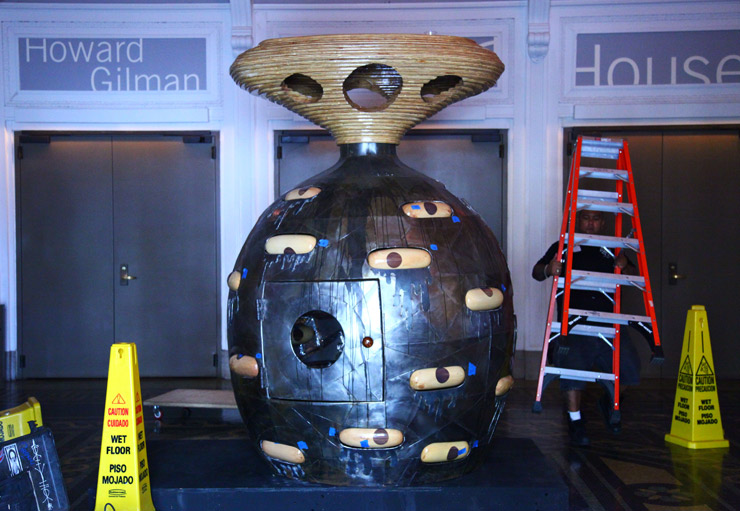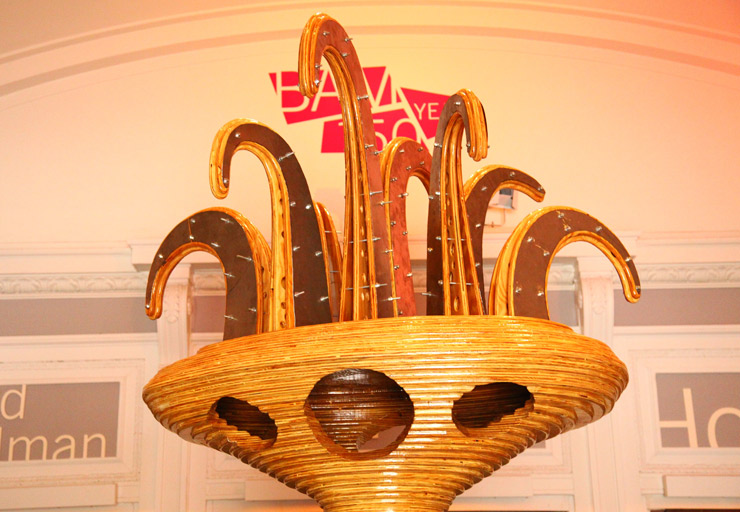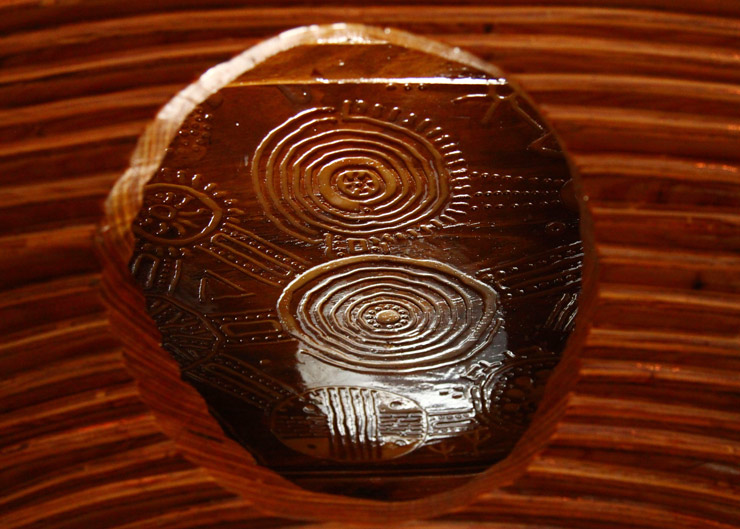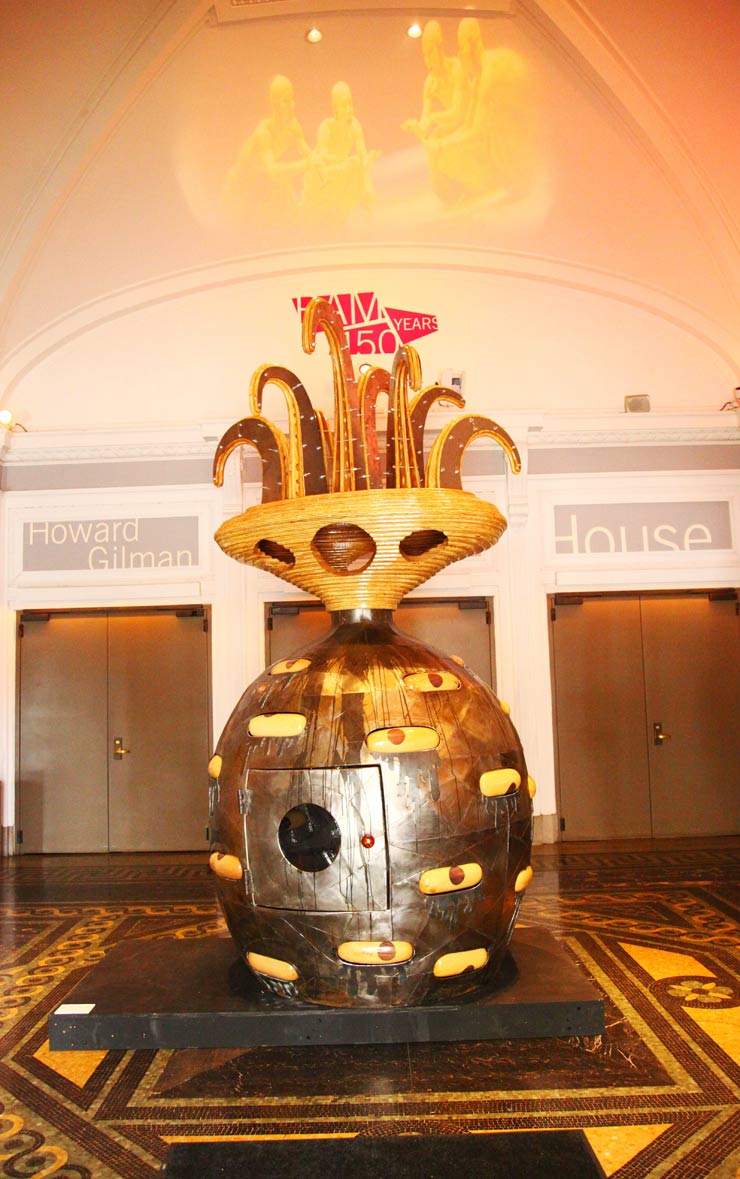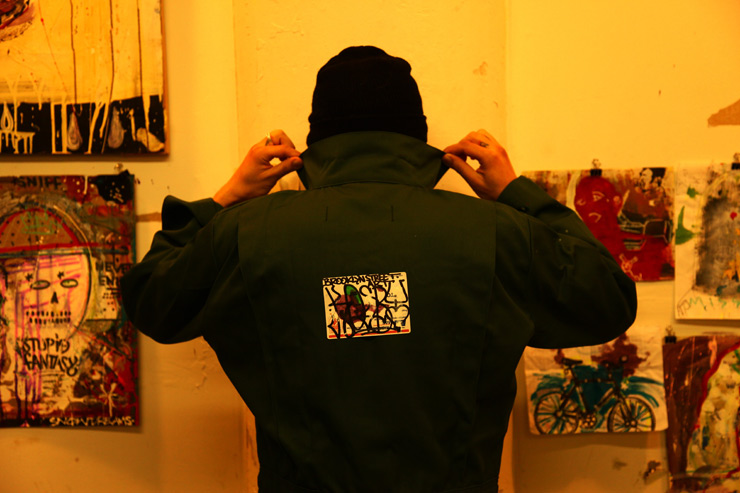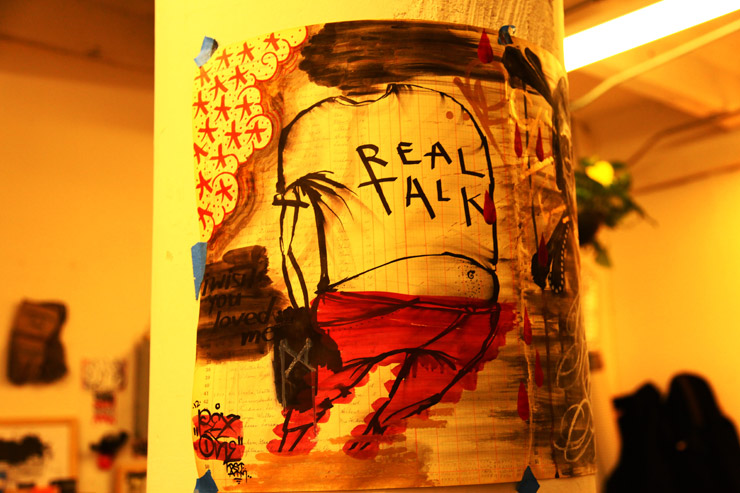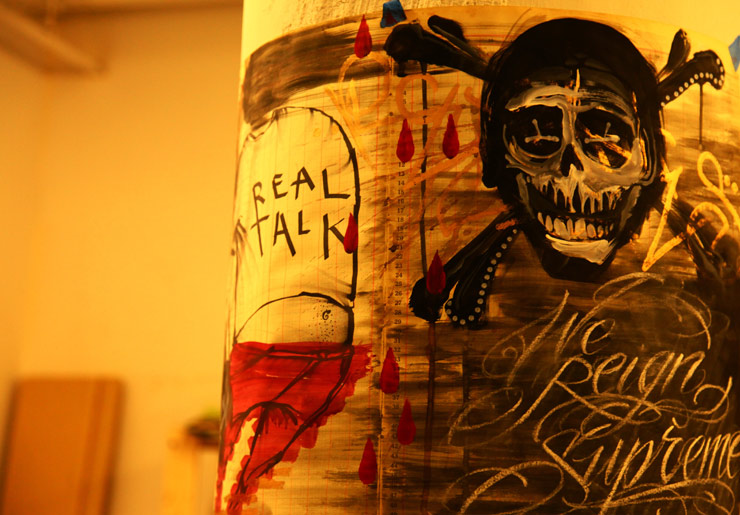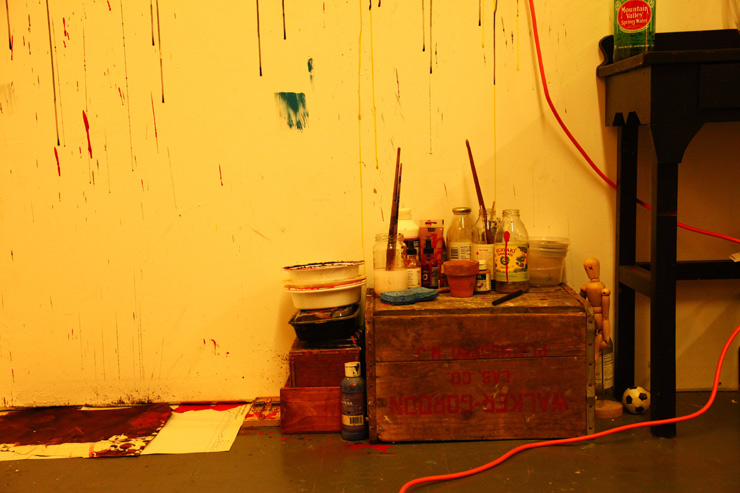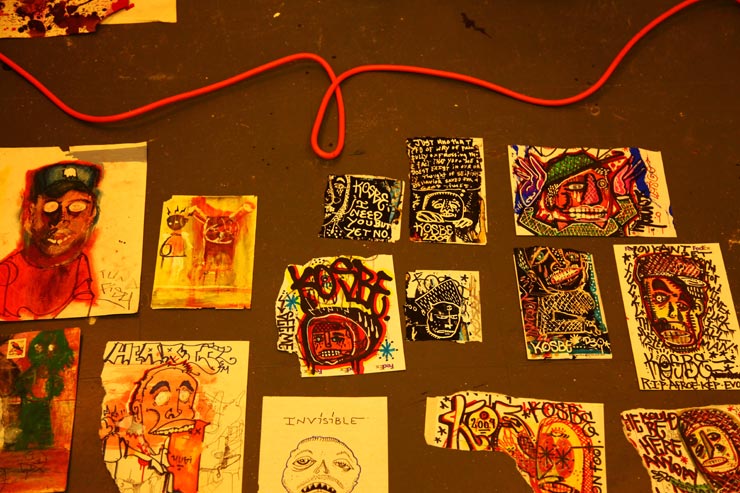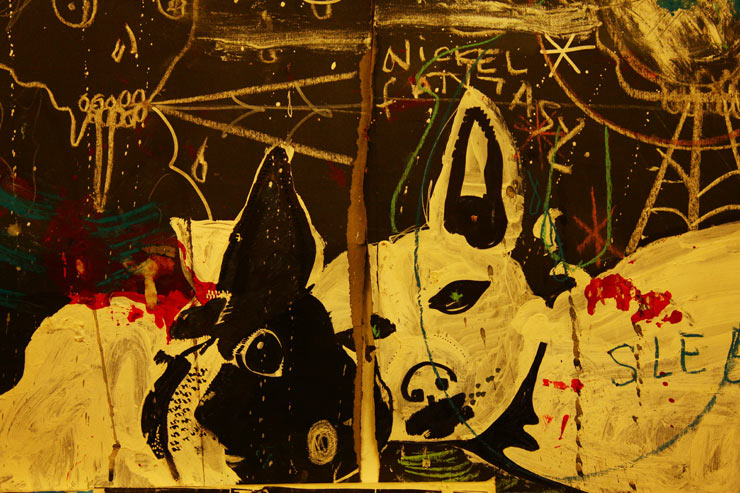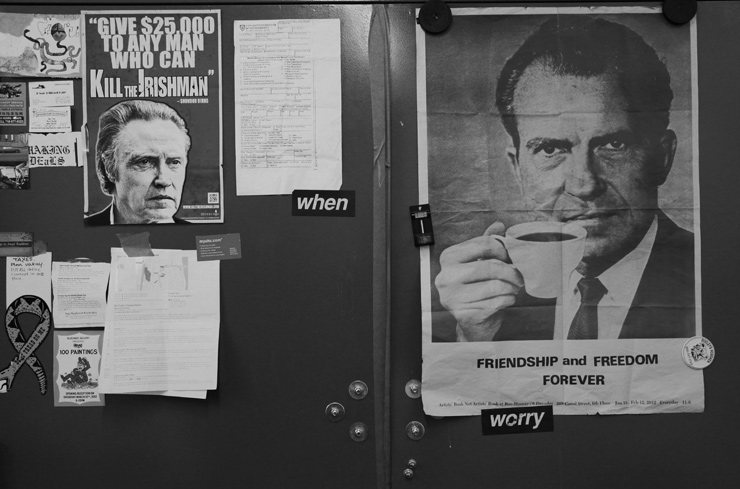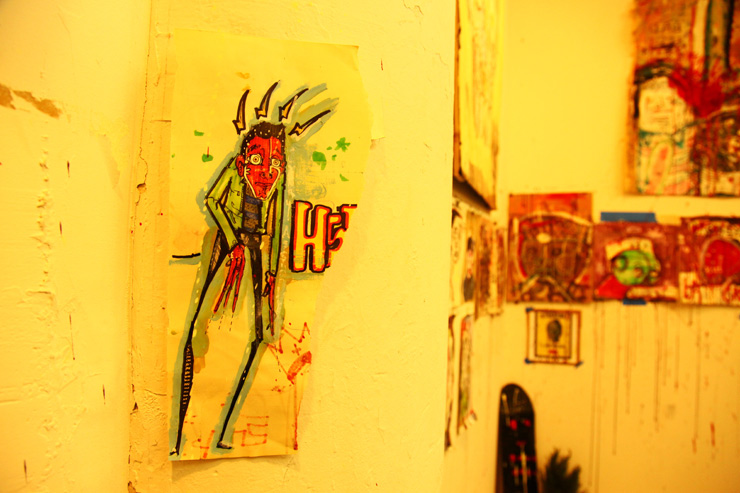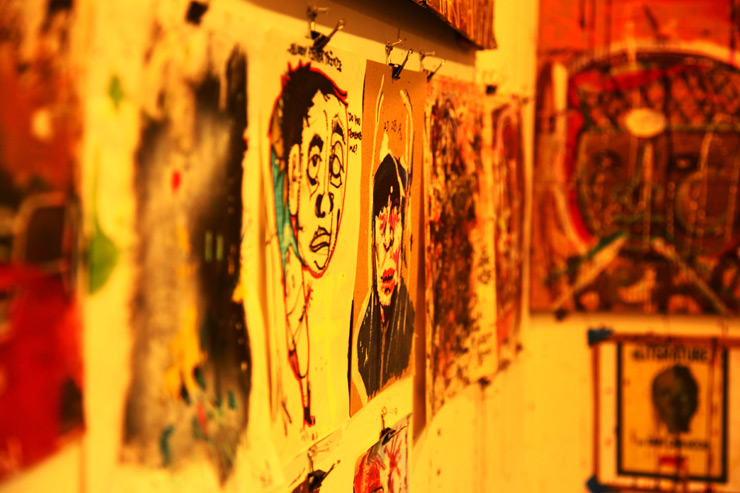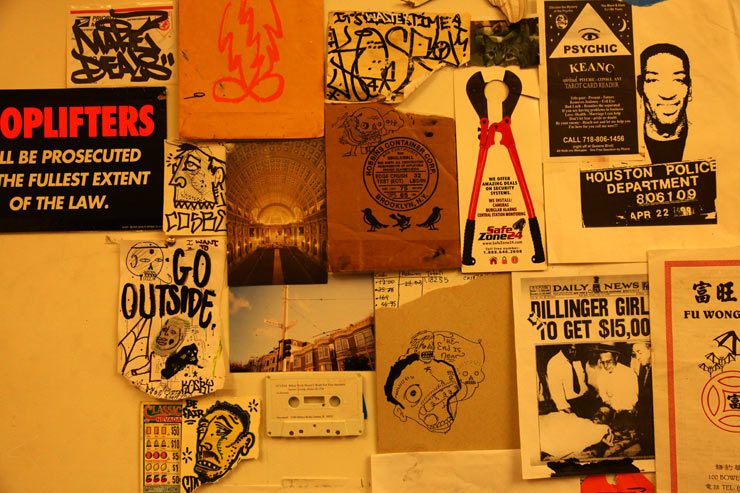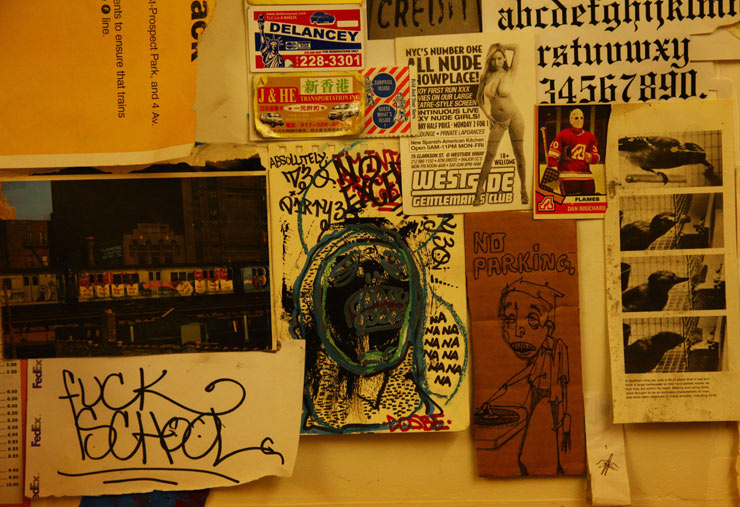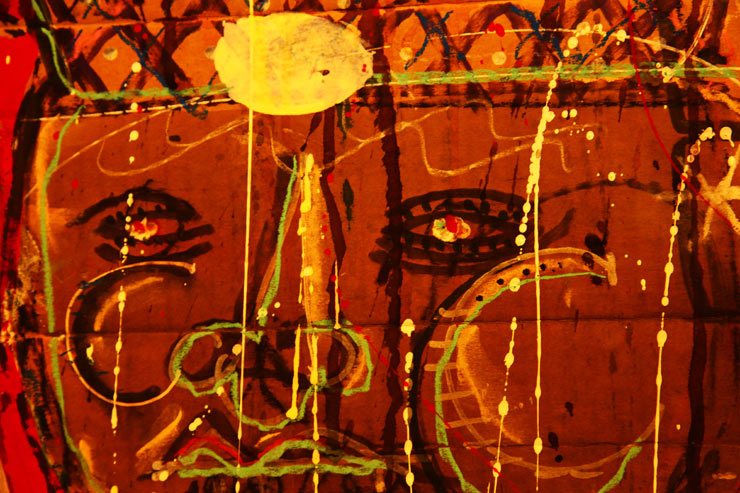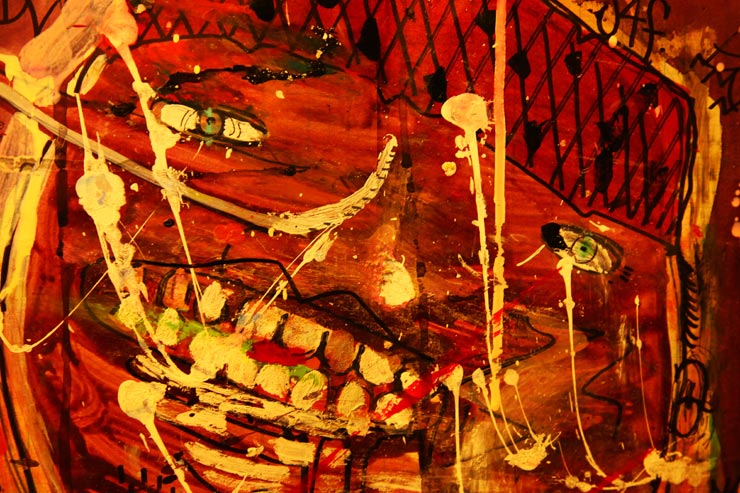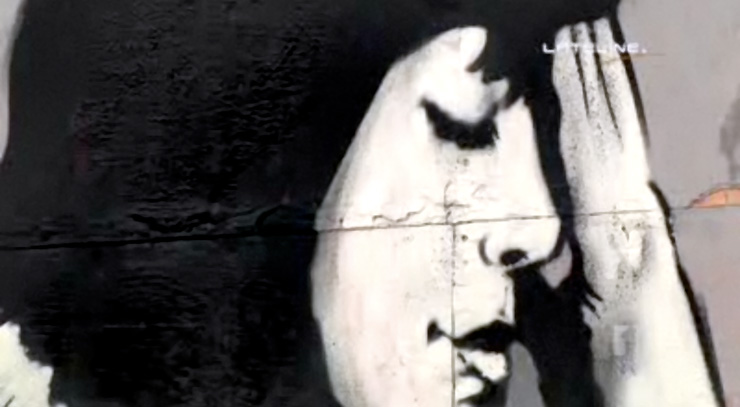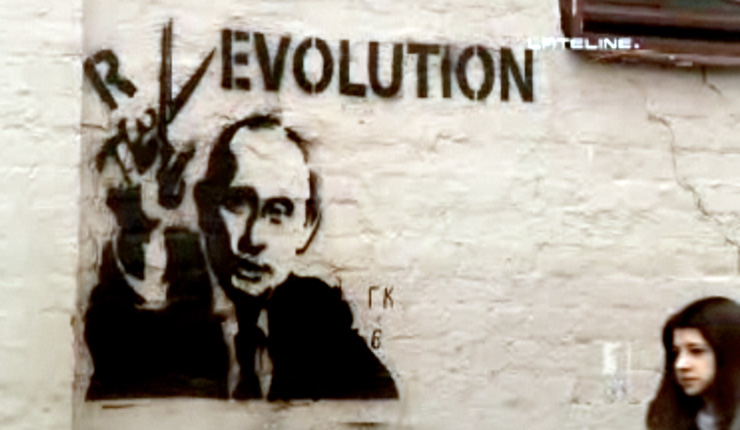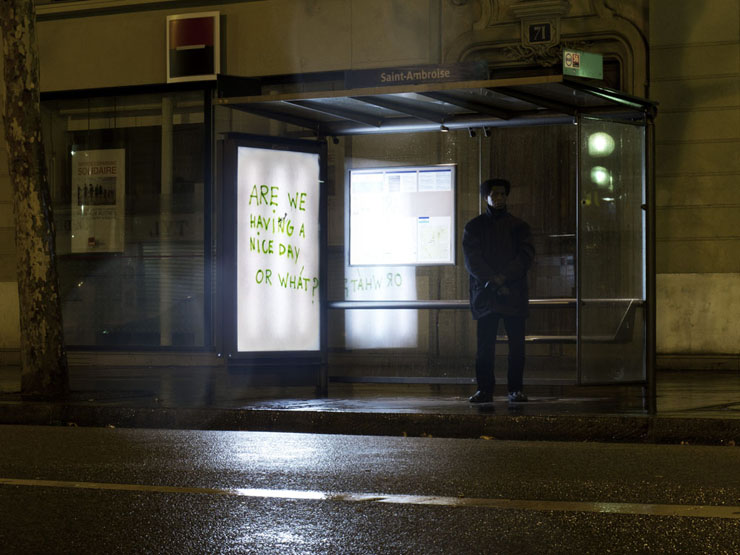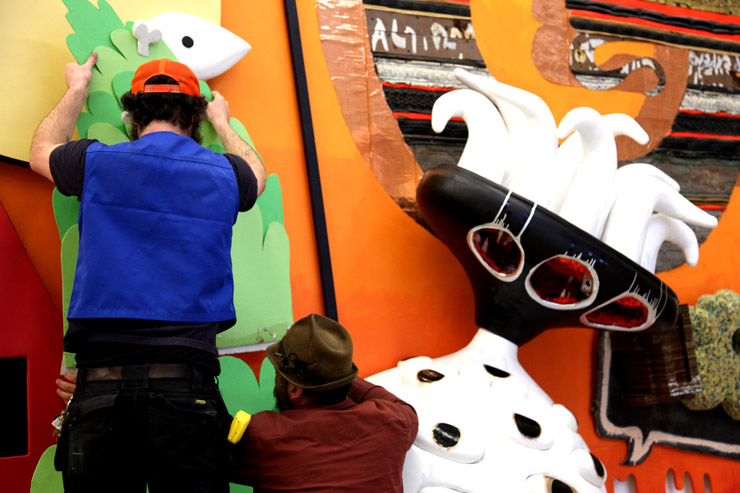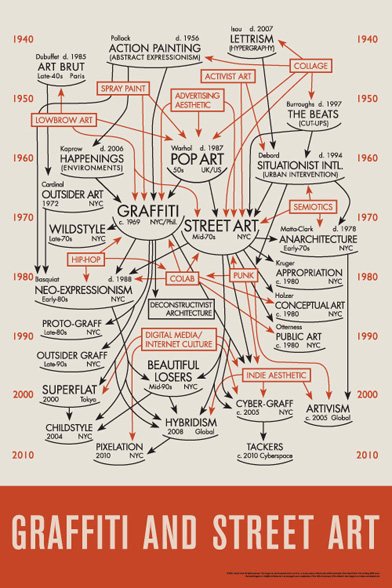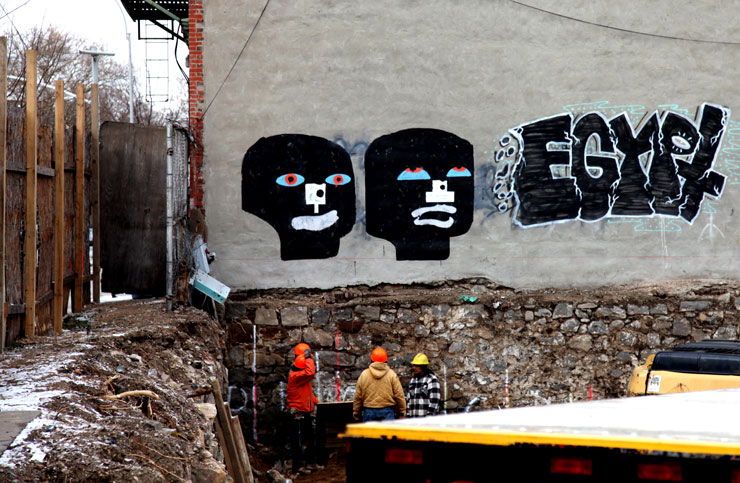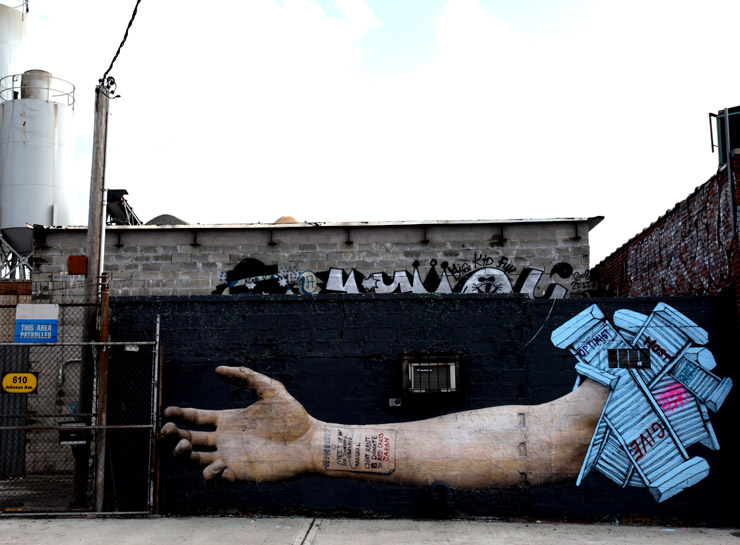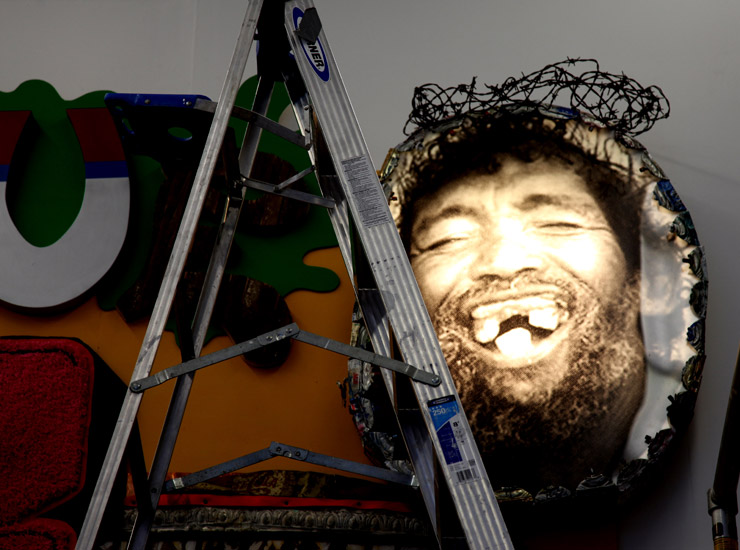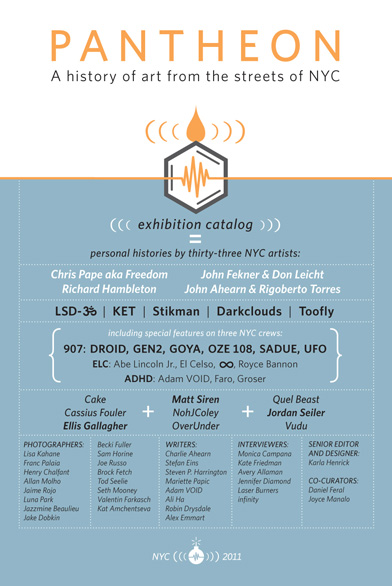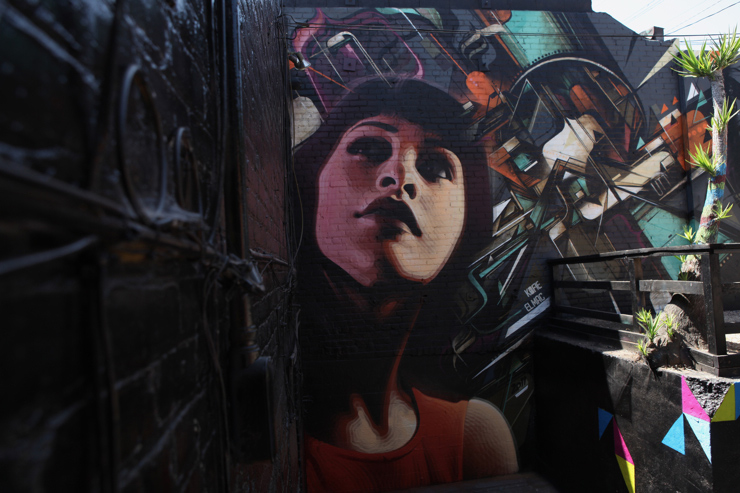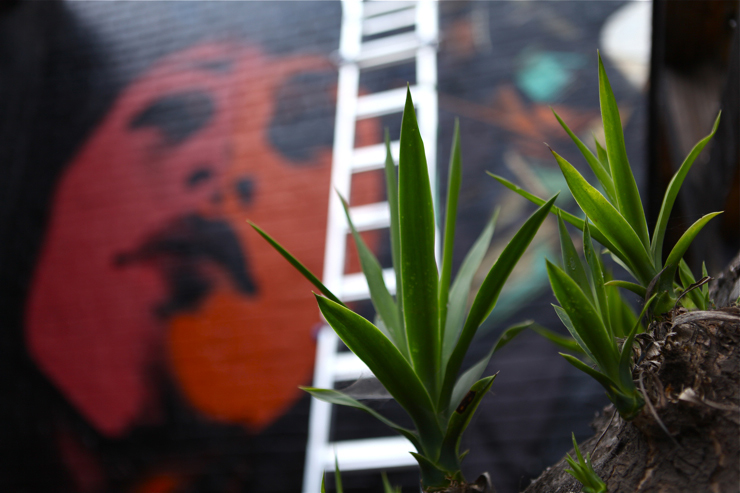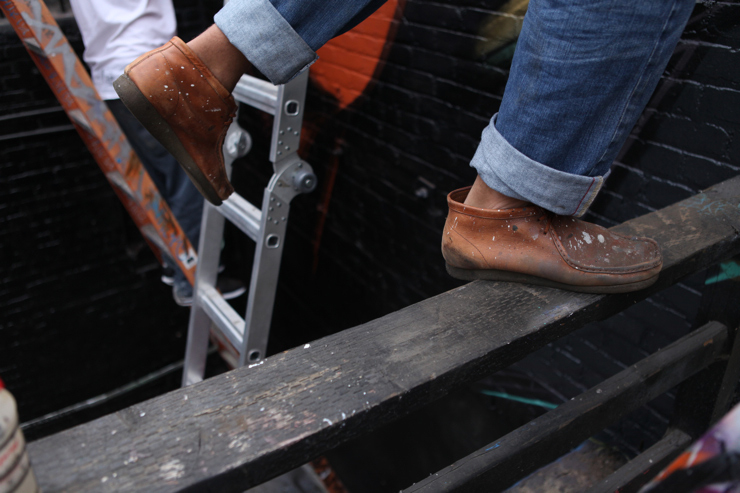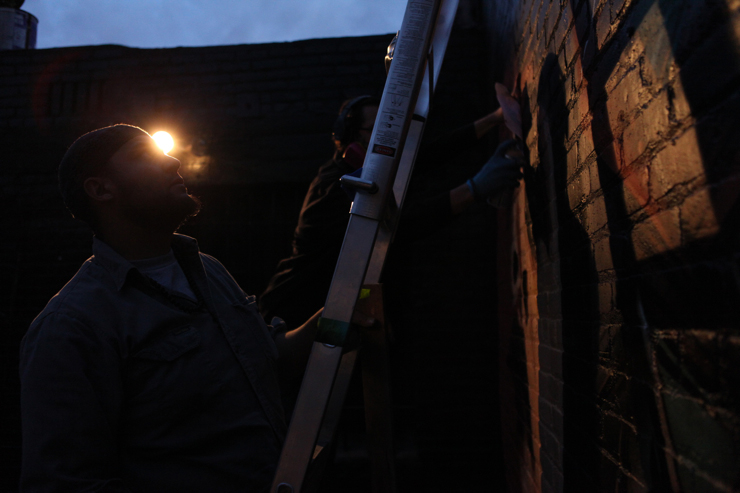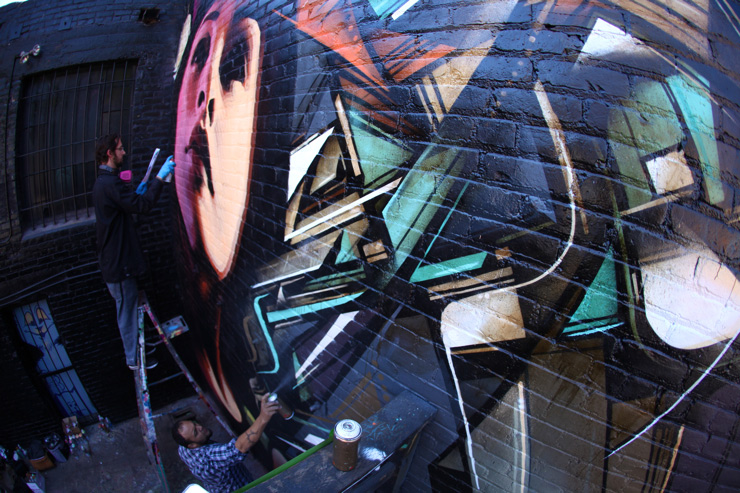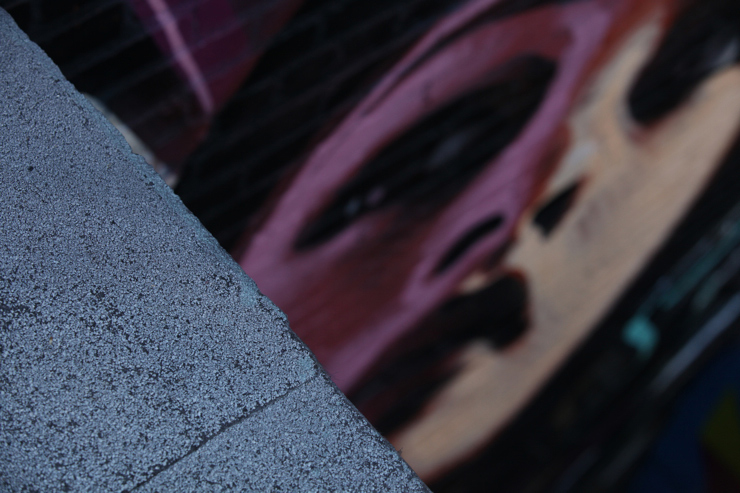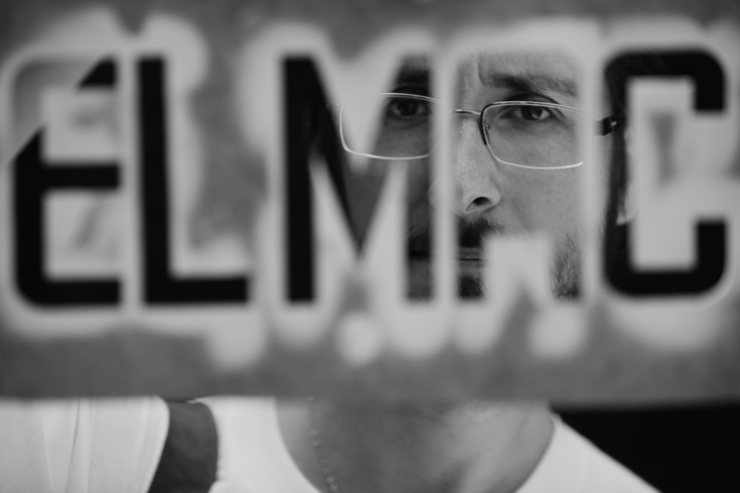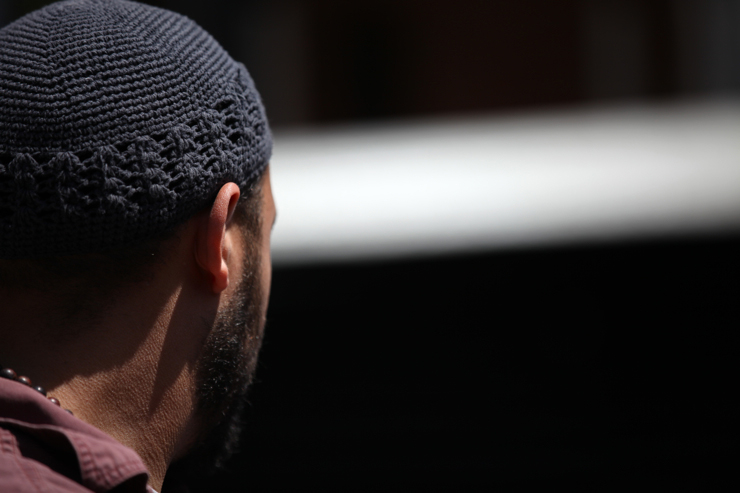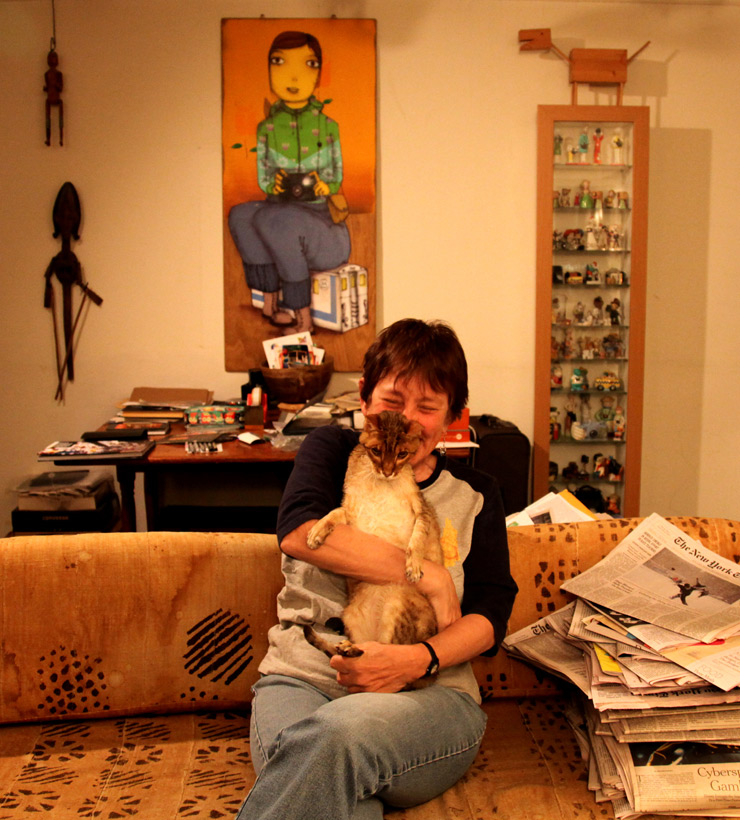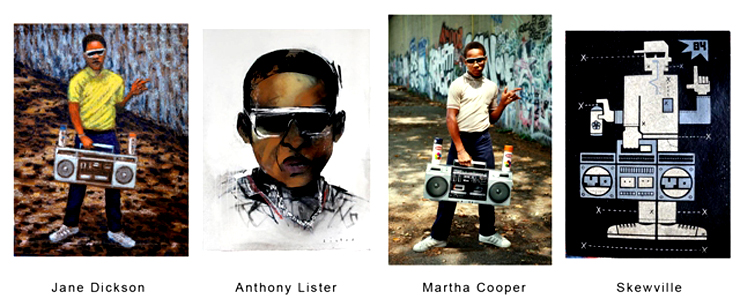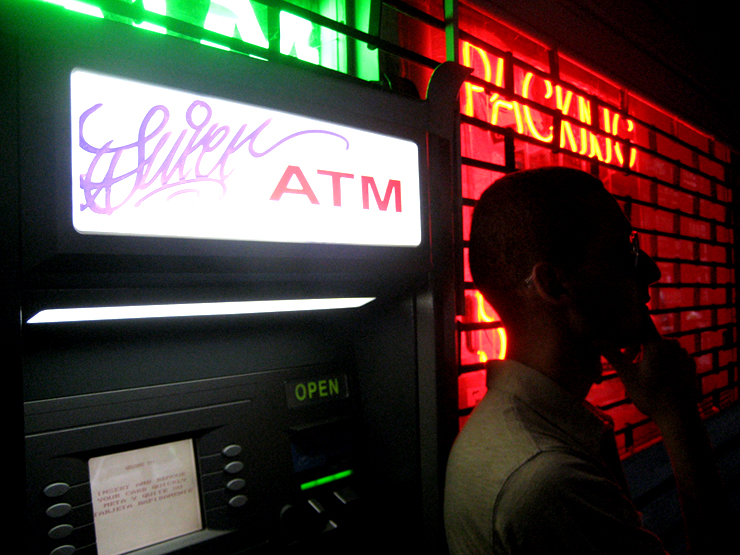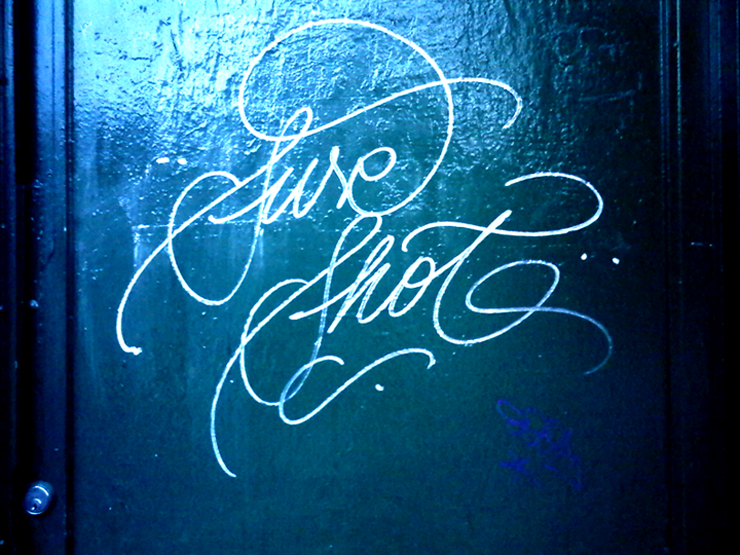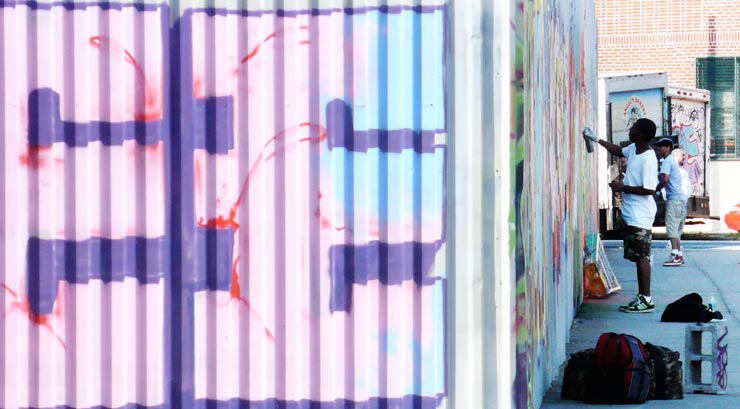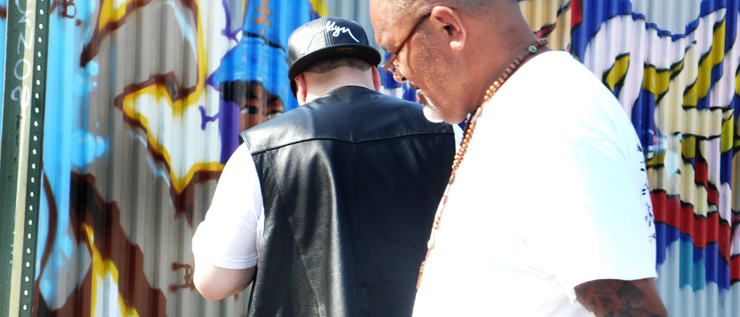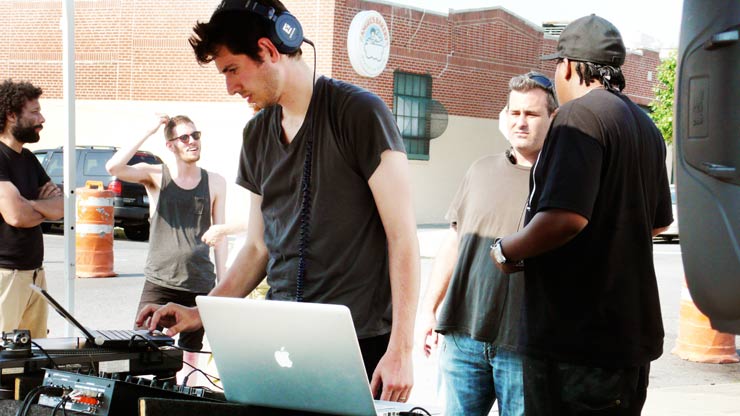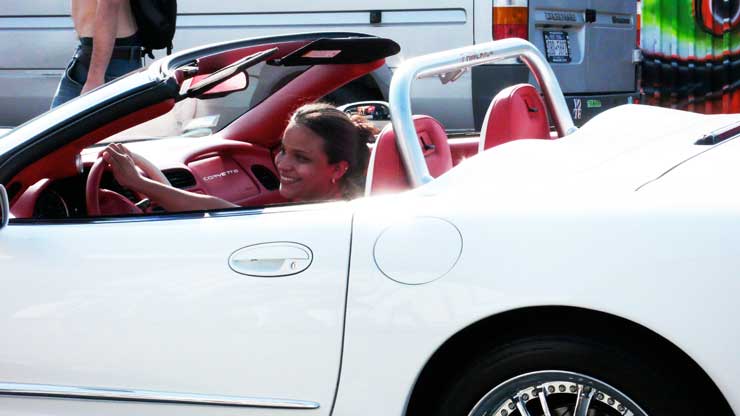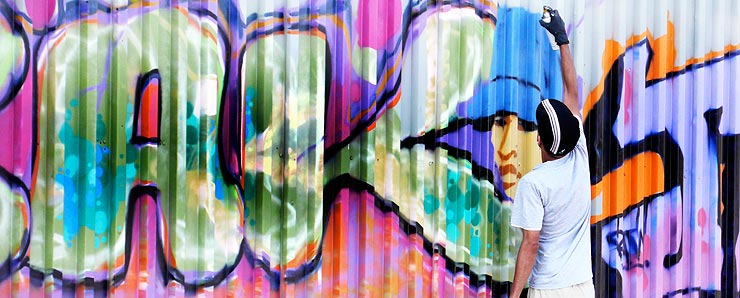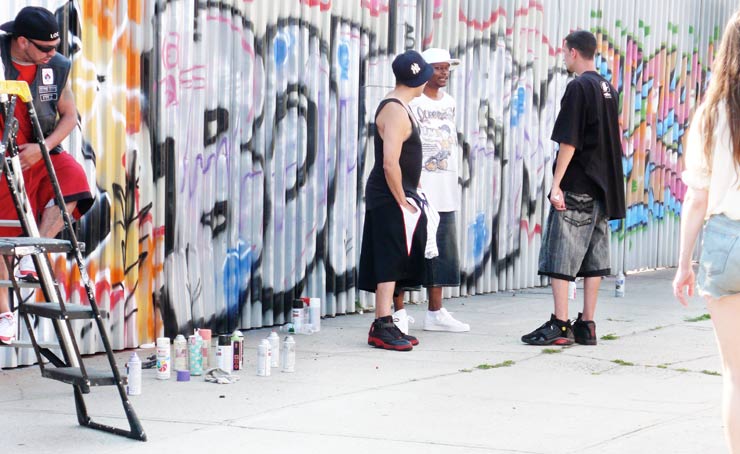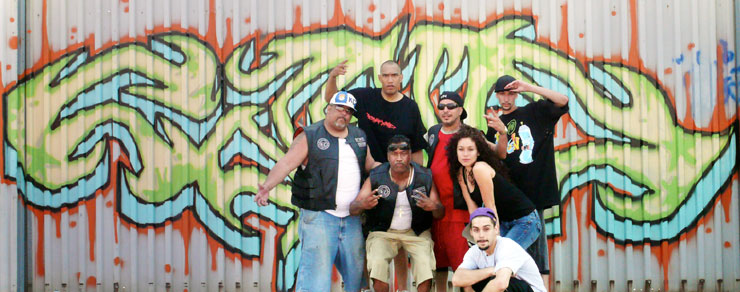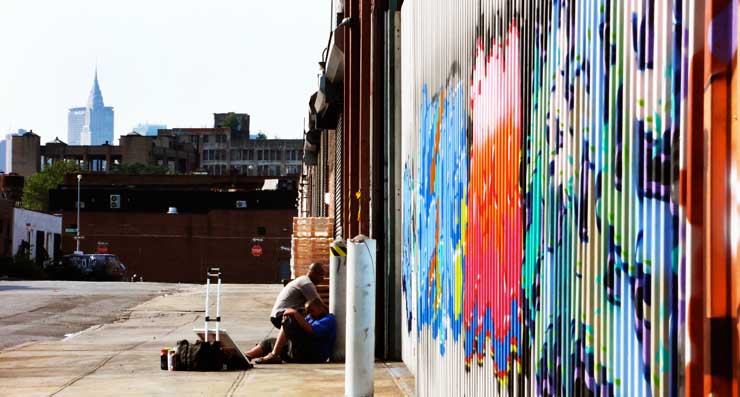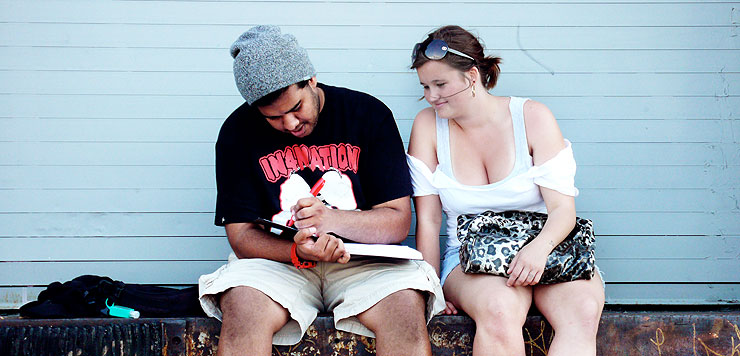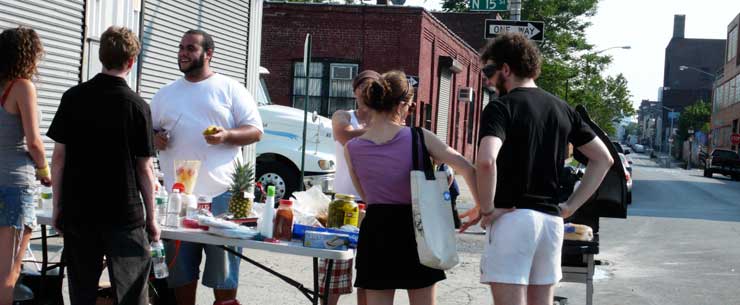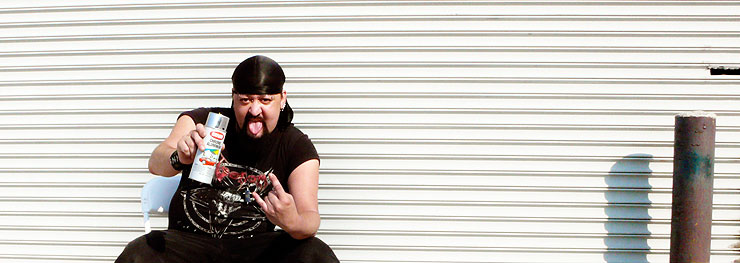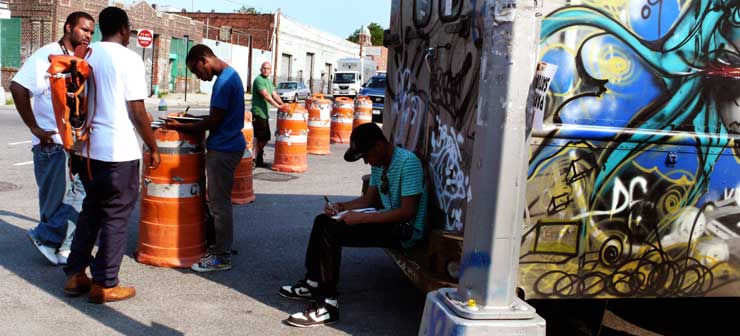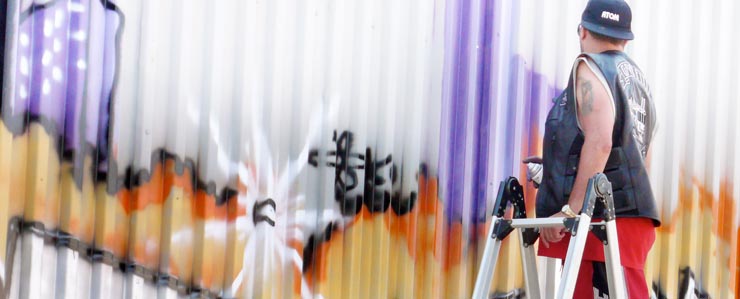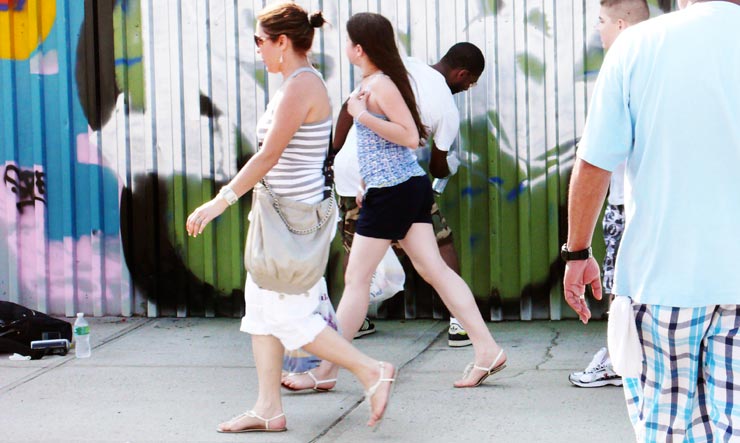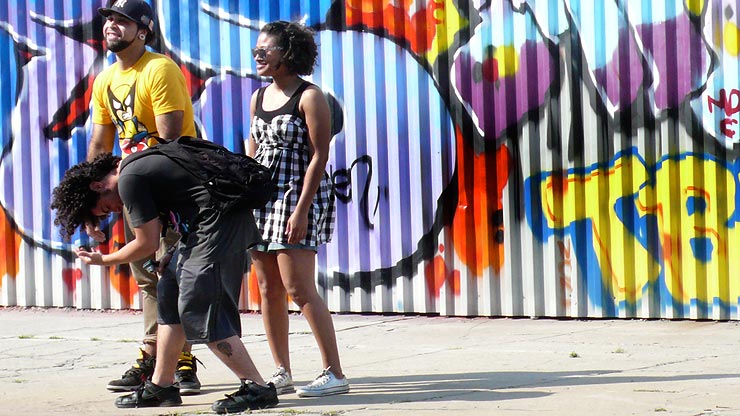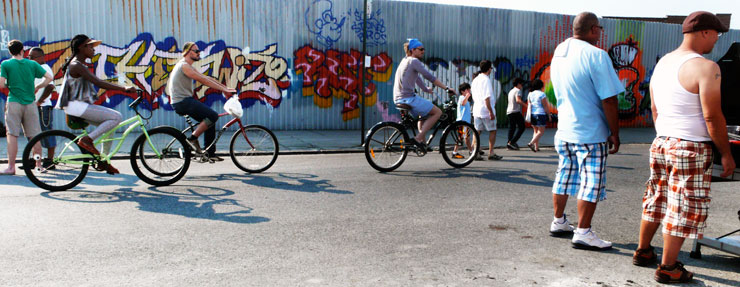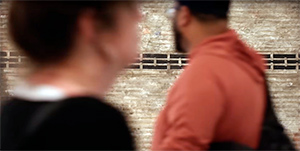UFO 907 & W. Thomas Porter Unveil Giant Wood / Metal Sculpture With 34 Eyes
“I think this is the kind of art work that people can step up to and they won’t say “Why the f*ck am I looking at this? I could do this – my kid could do this! I wanna blow people’s minds. I want people to be awestruck by it,” W. Thomas Porter exclaims in a burst of unhinged bravado that a master metal worker and inventor can claim after 3 consecutive weeks of custom cutting, bending, molding, and welding a crash-landing space ship, a 3-D realization of the UFO 907 graffiti moniker on it’s head.
UFO 907 and William Thomas Porter (photo © Jaime Rojo)
With the graffiti guy known on the street as UFO 907 as his master woodworking partner, Porter has crawled like a monkey inside, around, and on top of every inch of this metal-skinned vessel with 34 rotating smooth wooden eyes. Standing inside a Brooklyn studio staring up at this audacious labor intensive sculptural blast-off of inspiration and technical handy-work, you can’t believe that this is the same UFO who jumped roofs and trains for years spraying a rapid flat version of this ubiquitous alien vessel.
907 Crew fans may also experience a mind-melt when hearing first hand the soaring descriptive narrative UFO lets loose about this brand new street piece, “It’s a symphony between wood and metal. Seeing the wood next to the metals – it’s almost like jewelry work, it’s like it’s growing up out of the earth like a flower. It’s totally looking like this flower that is blooming, this metal is blooming out of all of this wood. It’s fun, man.” A tough NYC street graffiti writer who sometimes get’s dragged into the uncomfortable position of being called a Street Artist? Nah, UFO is just an artist now, and the usually shy guy is so ripped about this project he frankly doesn’t care about the label. It’s about the work.
UFO 907 and William Thomas Porter (photo © Jaime Rojo)
Introduced last night at a reception hosted by The Brooklyn Academy of Music, this UFO will house a stash of copies of Showpaper, a free print publication that lists and promotes events and DIY culture all around New York. Commissioned with funding from BAMart: Public, the “Brooklyn Shelf Life Project” is Showpaper’s hand picked selection of Street Art affliated artists collaborating as pairs to create innovative new versions of the traditional street kiosk. Curated by Andrew H Shirley, the eclectic collection of street explorers also includes Adam Void & Gaia, Cassius Fouler & Faust, Leon Reid IV & Noah Sparkes, and Ryan C. Doyle & Swoon.
A sketch to the side of this preliminary mockup shows the full scale of the piece by UFO 907 and William Thomas Porter (photo © Jaime Rojo)
A carpenter by trade, UFO 907 has been at it for 16 years but he didn’t try his hand at exploring his own graffiti tag in 3D till a few years ago. “It only made sense – I mean after over a decade drawing that stupid guy on the wall I began to wonder what he looked like in 3 dimensions…now I’m starting to wonder what the dude looks like in 5D!”
Porter says he started his path to metal work as a boy, tearing up old houses and rebuilding them with his father. “I’ve been making sculptures since I was 14, had no idea there was an art world then,” he says. Now that he is newly situated in his own Brooklyn studio, he’ll definitely be making more of his custom bike configurations (see his “F*ck Bike”) among other metal bending discoveries, “I’ve always been into material mashups,” he explains, “I started welding at 16, and metal became a gateway drug to all sorts of new possibilities.”
UFO 907 and William Thomas Porter (photo © Jaime Rojo)
UFO 907 and William Thomas Porter (photo © Jaime Rojo)
While touring through their respective studios, BSA had the opportunity to see the entire process of making the new sculpture for BAM, entitled “The End If the Beginning”. It was also good to talk with UFO 907 and W. Thomas Porter about how they teamed up, who the UFO character symbolizes, and what they’ll think if the sculpture gets vandalized on the street.
Brooklyn Street Art: When people think of UFO 907 on the streets, it’s a quick tag with not much detail. Don’t you think they would be pretty shocked to know how much time you put into a sculptural piece like this?
UFO 907: I guess so. If there’s one thing I’ve learned all these years in the graffiti game is you never know what your going to get when you uncover the man behind the moniker.
I’ve always felt a kind of separation between my vandalism tendencies and my artistic urges. Sure my tags and retarded throwups can look artistic but it’s just a quick elementary thoughtless expression. I’m doing the macho getting up sh*t, pissing like a dog. But with my studio work I slow down to a f*cking snails pace, considering every detail, knowing each line of the brush/pen, each turn of the jigsaw, each stroke with the sander is injecting so much f*cking feeling and energy and power into the piece. So, if ya didn’t know, now ya know.
UFO 907 and William Thomas Porter (photo © Jaime Rojo)
UFO 907 and William Thomas Porter (photo © Jaime Rojo)
Brooklyn Street Art: What part of this new piece are you most proud of?
UFO 907: I’m pretty excited to have the opportunity to work to such a large scale. I also always had a desire to fabricate a larger-than-life UFO piece and just love the idea of using metal. And of course I’m totally stoked to have the opportunity to be collaborating on such an intense piece with an artist and craftsmen I hold in high regard, W.Thomas Porter.
Brooklyn Street Art: The first time we saw a sculptural UFO it was with Ad Hoc Projects for a group show in Miami. The piece was called “Williamsburg Guy”. Was that the first time you did something like that?
UFO 907: No, I have built a few smaller wooden UFO pieces before the “Williamsburg Guy” piece, and over the years I have messed around with some other materials to find the form I’m looking for.
Funny story about the first time we showed “Williamsburg Guy”;
The night we finished the piece I slapped together a crate and Doyle and myself threw the piece underneath the Chinatown bus, and took it down to Richmond Virginia for a group show we were involved in. If you know the size and weight of the piece that’s a pretty impressive feat. But it was free shipping! Go Chinatown Bus!
UFO 907 and William Thomas Porter (photo © UFO)
UFO and William Thomas Porter (photo © Jaime Rojo)
Brooklyn Street Art: Since this is a vessel of sorts, and you have said your UFO tag is almost a self portrait, do you imagine yourself inside this sculpture looking out windows and swinging your 34 eyes in all directions looking at people?
UFO 907: Not necessarily but I love that idea! At this point it seems less like being inside the sculpture – but more so I continue to see the UFO as an embodiment of my being. I have always seen the UFO as my self portrait, yes, but not in the sense of a photograph or painting of myself. It’s more like a window to my spirit energy and soul. The form, energy and idea behind UFO has continuously been evolving, morphing, and growing over the years. If it wasn’t it would be dead, right?
So, yes, I’m guessing at some point you might just find me sitting inside the mothership staring at ya’ll, plotting my next move. Ha ha HA!
Brooklyn Street Art: When you are making such labor-intensive carefully considered work and putting it out into the street, do you ever worry about it being vandalized?
UFO 907: Naw… that’s what happens to sh*t on the streets! I kind of secretly have a fantasy about a car running up the sidewalk and crashing into the piece. That would be pretty cool, as long as I get a nice photo of the piece pinned between the car and a brick wall!
Brooklyn Street Art: What has working with Thomas brought to your process?
UFO 907: I have been a fan of his work and his great craftsmen ship since I met him. I think I first met him the night me and Doyle were cramming to get “Williamsburg Guy” completed. Dude came through and he quietly handled shit, helping us get the piece done. Aces!
When I first heard that Andrew Shirley was curating this project, I told him I had to be on board and wanted Tom Porter as my partner. Tom has brought amazing metal work, which is not my craft but a material I love all the same, and he is a champ with the kinetics/mechanics helping us both bring our visions to life and adding many levels to the piece. As well Tom Porter is a perfect match with me with his boundless energy, obsessive attention to detail, grand positive visions, eternal positivity directed towards the project at hand. What a dude!!
UFO 907 and William Thomas Porter (photo © Jaime Rojo)
UFO 907 and William Thomas Porter. Inside view of the structure. (photo © Jaime Rojo)
Brooklyn Street Art: Yeah, your skills seem really well suited for collaboration.
UFO 907: Yup we both have brought what we do best to the table and all thing immediately fell into place, leading to a seemingly effortless symphony of materials and ideas.
Brooklyn Street Art: Thomas, when you think of the sense of balance this piece has to have, do you rely on lessons learned from building other projects?
W. Thomas Porter : We set out on this project without any concept of limitations. We just decided what we wanted to get out of it and said, “F*ck it, it’s on”. I think that confidence comes from having been a builder and a bizarre mind forever. Everything I’ve done leads me to this moment. We have to come correct.
Brooklyn Street Art: Is it difficult to carry a demanding project like this across the finish line? Do you get tired of the detail work?
W. Thomas Porter: I don’t think it’s easy to get anything actually “finished”. Starting things is easy but getting there can be war. We are up against a tough deadline, a limited budget, working for money, UFO and I both just started new studios…it’s been hectic. As for the details, I’m with the devil. Every detail is an example or the bigger picture; it’s the fabric, and the pattern, the feel and what you see.
Brooklyn Street Art: This is a collaborative piece using the skills of a metal worker and a wood worker. How did you achieve an organic feeling with such rigid and sturdy materials?
W. Thomas Porter: It’s amazing to work with someone like UFO; Half man, half beast and all gusto. We both came to a similar place by working with our hands while our brains are off in the universe. It’s only a matter of time before that all explodes into space! I always loved wood and metal together, flesh and bone. In this case, I had to make steel feel like skin, and without a single straight line anywhere – it’s a challenge. I was blessed to have a dedicated assistant like Dagga to help plow through the process. Out of extremely limited means we came up with something greater than the sum of its parts.
UFO 907 and William Thomas Porter (photo © Jaime Rojo)
UFO 907 and William Thomas Porter (photo © Jaime Rojo)
UFO 907 and William Thomas Porter (photo © UFO)
UFO 907 in the wild. (photo © Jaime Rojo)
UFO 907 in the wild. (photo © Jaime Rojo)
UFO 907 and William Thomas Porter. The sculpture arrived to BAM in parts. Here is one half. (photo © Jaime Rojo)
UFO 907 and William Thomas Porter. Inside view of the armature. (photo © Jaime Rojo)
UFO 907 and William Thomas Porter (photo © Jaime Rojo)
UFO 907 and William Thomas Porter (photo © Jaime Rojo)
UFO 907 and William Thomas Porter (photo © Jaime Rojo)
UFO 907 and William Thomas Porter (photo © Jaime Rojo)
“The Beginning if the End”, 2012, by UFO 907 and W. Thomas Porter
Materials: Yellow Pine, Walnut, Plywood, Epoxy, Cold Rolled Steel, Hot Rolled Steel, Bearings, Ball Joints, Hardware, WaxAssistants: Dagga Gaines, Kelsey Womack, Jumbo, Diego Guzman, Sadue 907, and Hest One
“Brooklyn Shelf Life” is Presented by SHOWPAPER and curated by Andrew H. Shirley. Newsboxes commissioned by BAM for BAMart: Public.
Go to http://brooklynshelflife.org/ to learn more about this project. Joe Ahearn, Managing Director
Go to BAMart: Public to learn more about this program.
Stay tuned to BSA as tomorrow we’ll feature the rest of the sculptures of “Brooklyn Shelf Life” by Leon Reid IV + Noah Sparkles, Cassius Fouler + Faust, Swoon + Ryan Doyle and Gaia + Adam Void. Also you can visit the Showpaper Tumblr http://showpaper.tumblr.com/ for more images.
This article is also published on The Huffington Post
<<>>><><<>BSA<<>>><<<>><><BSA<<>>><><<>BSA<<>>><<<>><><BSA
Please note: All content including images and text are © BrooklynStreetArt.com, unless otherwise noted. We like sharing BSA content for non-commercial purposes as long as you credit the photographer(s) and BSA, include a link to the original article URL and do not remove the photographer’s name from the .jpg file. Otherwise, please refrain from re-posting. Thanks!
<<>>><><<>BSA<<>>><<<>><><BSA<<>>><><<>BSA<<>>><<<>><><BSA
 BROOKLYN STREET ART LOVES YOU MORE EVERY DAY
BROOKLYN STREET ART LOVES YOU MORE EVERY DAY